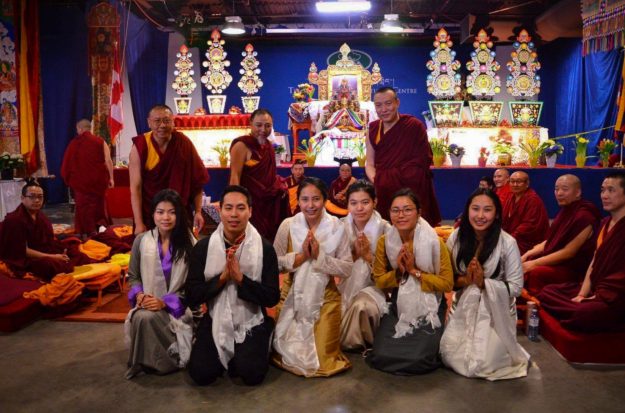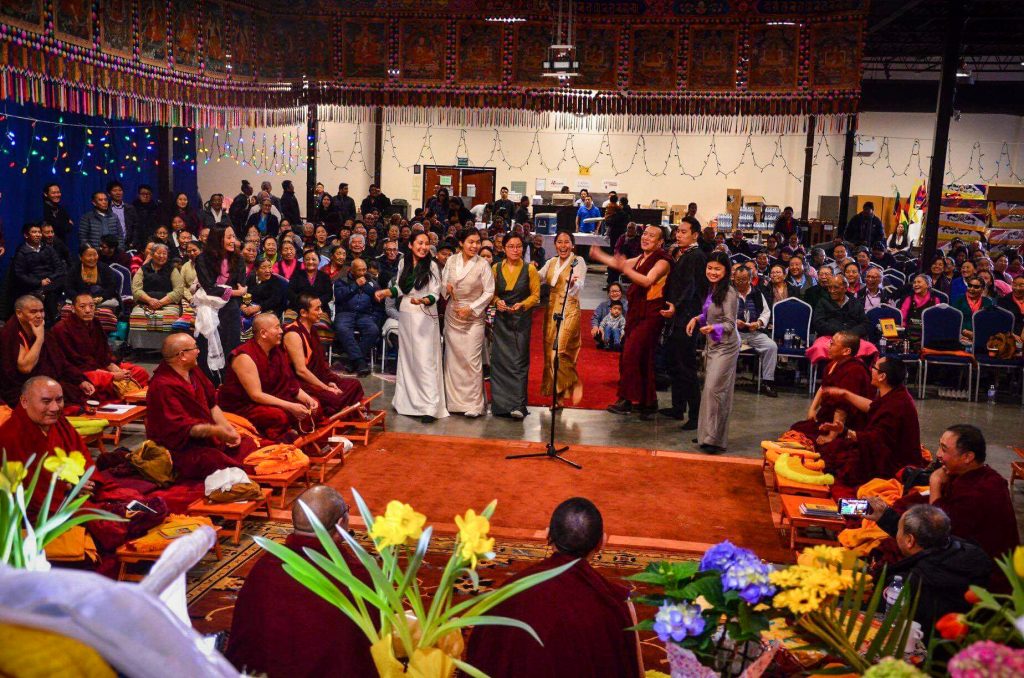As a Tibetan growing up in small town Canada, I was always interested in Tibetan Buddhism and spirituality. Like most Tibetans, my amala (mother) and pala (father) used one bedroom of our house as a chokgang (shrine room). But I never rigorously studied the dharma until last year when I joined a Tibetan Buddhist philosophy class at Gajang Buddhist Centre in Toronto. Some friends of mine had started attending the classes while I was working as a journalist in Winnipeg. When I came back to Toronto last year, I joined them and was immediately hooked. And after about eight months of weekly classes, our genla (teacher) Geshe Gedun Dhundop broached the idea of debating to our small sangha, one of the first public debates in North America to feature lay people.
My first recollection of Tibetan monastic debate had to have been when I was young. I don’t exactly remember. Maybe the first time was during my childhood trips to Nepal to visit my momola (grandmother). I would always be taken to monasteries and follow my momola for kora (pilgrimage) without truly understanding why and would listen to my momola and popola teach me about the merits of the dharma. I remember peering through the cracks of a gate and witnessing monks, old and young, who seemed to dance as they debated. Arms raised, voices raised, hands clapping, rosaries clasped, crowds watching. I found Tibetan Buddhist debate to be a wonderfully intriguing and entertaining practice. But I had no idea what they were debating about, why they were debating, or that one day I would actually take part in one.
It’s hard to comprehend how much goes into a debate without practicing for yourself. I still haven’t completely wrapped my head around it. Buddhist debate is different from its Western counterpart. To debate is to extinguish ignorance and cultivate wisdom. It’s not only about winning but developing compassion by paving the path for your opponent to come to the same conclusion as you.
“The point of debating is to help one analyze. It’s a form of analysis,” says Geshe Dhundop. “Really there are three steps: first you listen to subject matter, then you go into a debate court and debate on the points you’ve learned, then you go back to your room and meditate on all of it.”
But despite its educational goal, the event was intimidating.
We were to debate with two very learned visiting geshes, monks who’ve devoted their lives to study in order to obtain a doctorate-like Buddhist degree, and it would take place during a large monlam (prayer festival) that they were conducting. The debate calls for a fastidious attention to detail with regard to all the rules and rituals that I did not fully understand. To make matters worse, it was going to happen in Tibetan, my native language that I am still learning. Nonetheless, I sheepishly agreed to take part, without fully knowing what I was getting myself into.
Everyone in our class was new to debate. Only one of the students, Chemi Lhamo, had ever taken part in a Buddhist debate the year before.
“The moment I was introduced to the concept of Tibetan Buddhist debate, it was very daunting,” Lhamo tells me. “It was an enriching experience. I would say there’s so much art to it. The hand gestures, the movement, everything has so much symbolism, that you learn a lot about not only the debate but also the culture.”

The debate we signed up for was on valid cognition. Not an easy subject.
“All phenomena in the world are broken down into thokpa (conceptualization) and thomey (non-conceptualization),” says Geshe Dhundop. “The debate was about how things are cognized. Between an object and the mind, how does conceptualization or imagination occur?”
So we studied the seven ways of knowing: direct perception, inferential perception, subsequent cognition, presumption, inattentive perception, doubt, and distorted mind. I learned that the quality of each source could be compromised by afflictive emotions and obscurations to wisdom, and that our individual karma can determine how we see objects, because there is always a relationship between the perceiver and the object. But I needed to also keep in mind the teachings on not-self, or no-self, that there is no independent self separate from the five aggregates (form, feeling, perception, compositional factors, and consciousness), as well as the teachings on emptiness, that everything is empty of independent existence. It took a lot of studying and introspection to understand the selflessness of self, to know that form is emptiness and emptiness is form.
We also practiced the structure and techniques of debate for months with genla and the other enthusiastic geshes at Gajang. We mapped out every potential response. And in the process, we learned Tibetan phrases and Buddhist concepts that we had never heard of before, while earning the respect of our genlas.
On the day of the debate, I was dressed in my favorite black wunju (men’s Tibetan shirt). The women were wearing their chubas (long sheepskin coat). I still wasn’t sure if I was ready, but I had the strength of my debate sangha and patient teachers. I entered the Tibetan Canadian Cultural Centre to a crowd of a few hundred adults and elders who were attending the yearly monlam. The geshes and monks were at the front of the center, already fiercely engaged in a debate with the two learned geshes, who were seated at the very front.
When it was our turn, we walked up to the front of the center. The crowd was captivated. Millennial lay people were lining up and preparing to debate. The energy in the center was electric. I felt a concoction of nervousness and adrenaline. I don’t think I’ve seen elders look so incredulous and joyful at the same time.
“They were surprised. They were shocked. They were like are you serious?” Lhamo recalls.
A line of text from scripture was used as a guide to start the debate. The two learned geshes were seated at the front, a group of geshes were sitting at each side. Prayer beads in hand, we stepped in unison as we clapped to put forth our question and statement. We debated on conceptualization for about 15 minutes.
“During the time of the debate, I saw myself coming up with conclusions that I never thought I would come up with by myself. Neurons were firing everywhere,” says Lhamo.
Everything we researched and rehearsed was going according to plan. But it took some quick and creative thinking in the moment to test the knowledge of the geshes. Near the end of the debate, we saw an opening.
Their final point asserted that with conceptualization, an object does not appear clearly, but with non-conceptualization an object does appear clearly. We asked them if that is 100% true. They said yes. So we used an example to poke a hole in their logic: What if you see a blue hue on a snow mountain? Whether it’s by wearing blue sunglasses or something else that alters your vision to blue, are you then seeing the mountain clearly? Their answer was no. So we asked whether that was conceptualization? If the mountain is not being seeing clearly because of the blue hue, wouldn’t that be conceptualization? With that, they realized the gap in logic. The crazy thing is that we somehow managed to make the two geshes lose their point.
Together we stumped the geshes. And the elders loved every minute of it. All of the other geshes were wondering who we were and how we were able to debate at the monlam.
“It was considered a great debate,” said my genla Geshe Dhundop. “Even though they didn’t study much, they were able to win their point.”
The general public probably didn’t understand what we were debating, but they were just excited that we took an interest in the practice.
“Usually it’s very rare to have lay people debating,” said Geshe Dhundop. “It’s even more rare for people to actually debate on logic, not just something they recite. I noticed there was a greater interest from the community when they debated against the monks. The geshes were all awestruck.”
Lhamo said, “I truly felt almost like a trailblazer because it was nice to see the community so accepting of something like this. Because it’s not often we see lay people debating, especially a young female.”
I left the debate with a better understanding of my rich heritage and an in-depth understanding of conceptualization. Both things that I will keep learning about until my last breath. I feel a deeper connection to my community. I’ve befriended a bevy of monks and geshe la says I’ve cultivated a lot of merit and good karma. Buddhist debate is no longer an abstract concept to me. I’ll use the experience and confidence gained from the debate to continue interrogating my spiritual practice through a logical lens. And who knows, maybe I’ll even debate again next year.
ཀྲོ་རོན་ཀྲོ་བོད་རིགས་སྤྱི་མཐུན་ཚོགས་པའི་ཚོགས་ཁང་དུ་གདན་ས་གསུམ་དང་རྒྱུད་གྲ་སྟོད་སྨད་གཉིས་ཀྱིས་གོ་སྒྲིག་འོག་ལྷ་ལྡན་སྨོན་ལམ་ཆེན་མོ་ཉིན་གསུམ་རིང་ཚོགས་བཞིན་པའི་སྐབས་བོད་རིགས་གཞོན་སྐྱེས་ཁག་གཅིག་གིས་རྟག་གསལ་གཏོང་བཞིན་པའི་རྙན་མཐུང་ཞིག་གཟིགས་རོགས་གནང་། A group of students are debating with Geshi la during the Laden Monlam chemo ceremony .
Posted by Tenzin Choephel Kharkhang on Wednesday, March 20, 2019
Thank you for subscribing to Tricycle! As a nonprofit, we depend on readers like you to keep Buddhist teachings and practices widely available.
